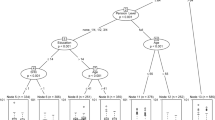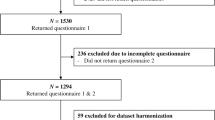Abstract
Study design:
Cross-sectional, survey.
Objectives:
To extend current theoretical models predicting life satisfaction post-spinal cord injury (SCI). Our primary model predicting life satisfaction as measured by the Satisfaction with Life Scale (SWLS) examined demographic characteristics, elements of the International Classification of Functioning and subjective and objective measures of health. A second model was developed to examine factors that are associated with successful community participation as measured by the Reintegration to Normal Living Index (RNL). In addition, the effects of psychological distress and chronic pain on life satisfaction and community participation were examined.
Setting:
Toronto Rehabilitation Institute, Spinal Cord Rehabilitation Program, Lyndhurst Centre.
Methods:
Prospective data collection via semi-structured telephone interview on an established SCI Canadian sample.
Results:
In predicting life satisfaction, our model accounted for 35.3% of the variance with demographic characteristics, objective and subjective health, and community participation significantly contributing to the model. In particular, psychological complications, current health rating and community participation were the only variables that made significant contributions in predicting life satisfaction. With regards to community participation, the presence of psychological complications and number of medical complications were associated with decreased reintegration. Increased time since injury onset, higher health ratings and being employed were positively related to RNL.
Conclusion:
It would appear that factors involving functional decline and aging are associated with lower participation but not life satisfaction. Further, models predicting quality of life should incorporate measures of psychological functioning.
Sponsorship:
Toronto Rehabilitation Institute
Similar content being viewed by others
Log in or create a free account to read this content
Gain free access to this article, as well as selected content from this journal and more on nature.com
or
References
DeVivo MJ, Krause JS, Lammertse DP . Recent trends in mortality and causes of death among persons with spinal cord injury. Arch Phys Med Rehabil 1999; 80: 1411–1419.
McColl MA, Charlifue S, Glass C, Savic G, Meehan M . International differences in ageing and spinal cord injury. Spinal Cord 2002; 40: 128–136.
Thompson L, Yakura J . Aging related functional changes in persons with spinal cord injury. Top Spinal Cord Inj Rehabil 2001; 6: 69–82.
Pavot W, Diener E . Review of the satisfaction with life scale. Psychol Assess 1993; 5: 164–172.
McColl MA . Expectations of health independence, and quality of life among aging spinal cord-injured adults. Assist Technol 2002; 11: 130–136.
Westgren N, Levi R . Quality of life and traumatic spinal cord injury. Arch Phys Med Rehabil 1998; 79: 1433–1439.
Dijkers MP . Correlates of life satisfaction among persons with spinal cord injury. Arch Phys Med Rehabil 1999; 80: 867–876.
Kemp BJ, Ettelson D . Quality of life while living and aging with a spinal cord injury and other impairments. Top Spinal Cord Inj Rehabil 2001; 6: 116–127.
Eisenberg MG, Saltz CC . Quality of life among aging spinal cord injured persons: long term rehabilitation outcomes. Paraplegia 1991; 29: 8–91.
McColl MA, Stirling P, Walker J, Corey P, Wilkins R . Expectations of independence and life satisfaction among ageing spinal cord injured adults. Disabil Rehabil 1999; 21: 231–240.
Pierce CA, Richards JS, Gordon W, Tate D . Life satisfaction following spinal cord injury and the WHO model of functioning and disability. Spinal Cord Inj Psychosocial Process 1999; 12: 24–127.
Putzke JD, Richards JS, Hicken BL, DeVivo MJ . Predictors of life satisfaction: a spinal cord injury cohort study. Arch Phys Med Rehabil 2002; 83: 555–561.
Richards JS, Bombardier CH, Tate D, Dijkers M, Gordon W, Shewchuk R et al. Access to the environment and life satisfaction after spinal cord injury. Arch Phys Med Rehabil 1999; 80: 1501–1506.
Fuhrer MJ . The subjective well-being of people with spinal cord injury: relationships to impairment, disability, and handicap. Am J Phys Med Rehabil 1996; 73: 358–364.
McColl MA, Rosenthal C . A model of resource needs of aging spinal cord injured men. Paraplegia 1994; 32: 261–270.
Krause JS, Kemp B, Coker J . Depression after spinal cord injury: relation to gender, ethnicity, aging, and socioeconomic indicators. Arch Phys Med Rehabil 2000; 81: 1099–1109.
Post MWM, de Witte LP, van Asbeck FWA, van Dijk AJ, Schrijvers AJP . Predictors of health status and life satisfaction. Arch Phys Med Rehabil 1998; 79: 395–401.
Charlifue SW, Lammertse DP, Adkins RH . Aging with spinal cord injury: changes in selected health indices and life satisfaction. Arch Phys Med Rehabil 2004; 85: 1848–1853.
Wood-Dauphinee SL, Opzoomer MA, Williams JI, Marchand B, Spitzer WO . Assessment of global function: the reintegration to normal living index. Arch Phys Med Rehabil 1988; 69: 583–590.
McColl MA, Arnold R, Charlifue S, Glass C, Savic G, Frankel H . Aging, spinal cord injury, and quality of life: structural relationships. Arch Phys Med Rehabil 2003; 84: 1137–1144.
Acknowledgements
We acknowledge the support of Toronto Rehabilitation Institute, which receives funding under the Provincial Rehabilitation Research Program from the Ministry of Health and Long Term Care in Ontario. We thank Kieva Richards, BSc, Michael Johnson, BA, Jennifer Greves, Dipl., Chad Greene, BA, and Andrea Brown, BSc, for their work on the project. We also thank the study participants for their time and support.
Author information
Authors and Affiliations
Corresponding author
Rights and permissions
About this article
Cite this article
Tonack, M., Hitzig, S., Craven, B. et al. Predicting life satisfaction after spinal cord injury in a Canadian sample. Spinal Cord 46, 380–385 (2008). https://doi.org/10.1038/sj.sc.3102088
Received:
Revised:
Accepted:
Published:
Issue date:
DOI: https://doi.org/10.1038/sj.sc.3102088
Keywords
This article is cited by
-
Quality of life after traumatic thoracolumbar spinal cord injury: a North Indian perspective
Spinal Cord (2023)
-
Life satisfaction 18 months and 10 years following spinal cord injury: results from a New Zealand prospective cohort study
Quality of Life Research (2023)
-
Satisfaction with life, health and well-being: comparison between non-traumatic spinal cord dysfunction, traumatic spinal cord injury and Australian norms
Spinal Cord Series and Cases (2019)
-
Development of a Self-Management App for People with Spinal Cord Injury
Journal of Medical Systems (2019)
-
Work and wellbeing-related consequences of different return-to-work pathways of persons with spinal cord injury living in Switzerland
Spinal Cord (2018)



